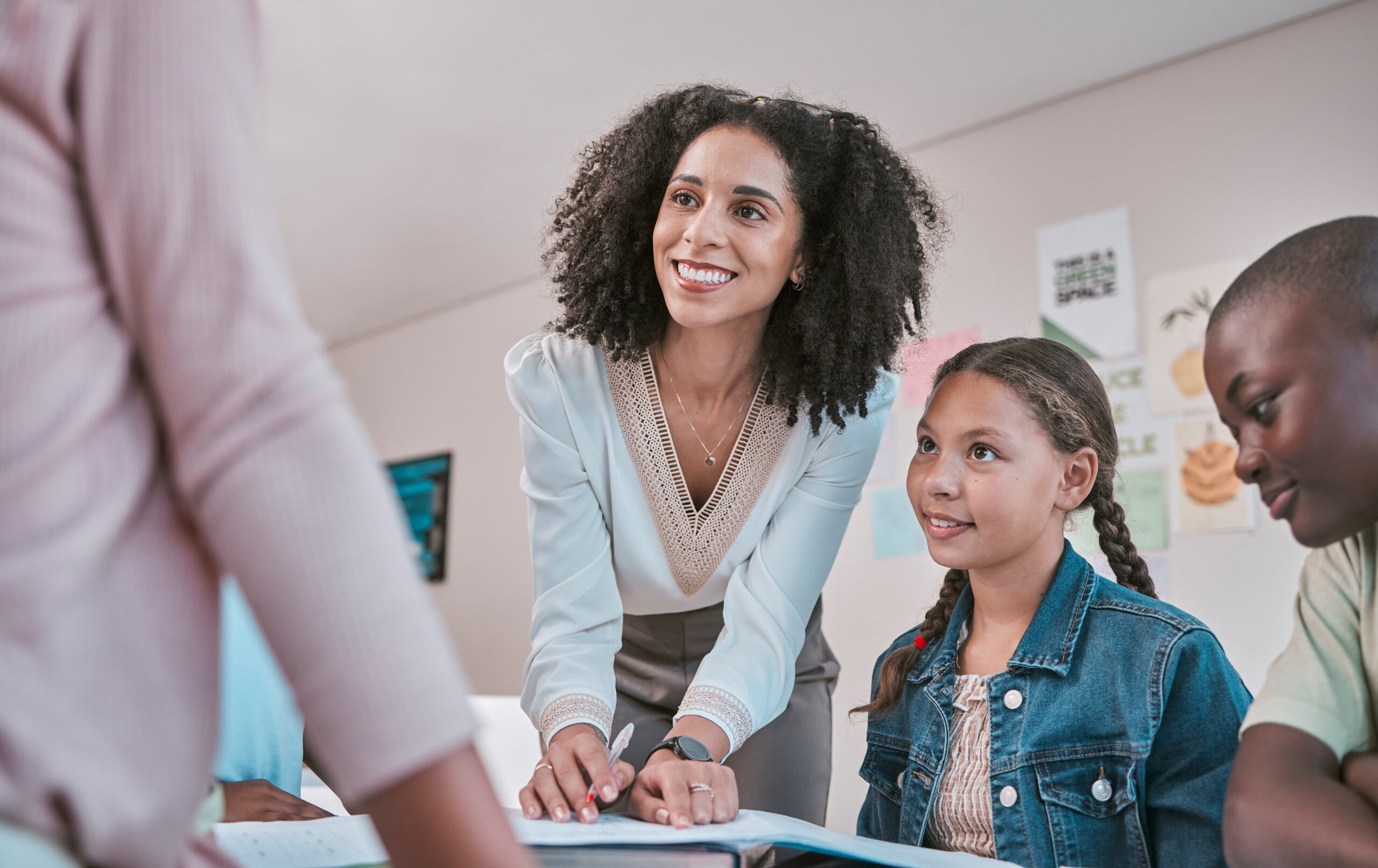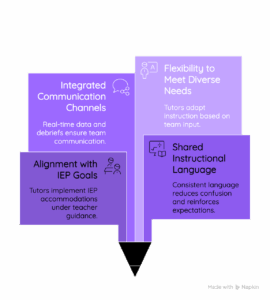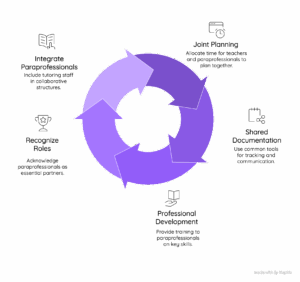
25 Sep Stronger Together: How Teacher-Paraprofessional Collaboration Improves SPED Outcomes
Written by Candice Morris | Edited by Cara Catalano
As student needs grow more complex, schools must ensure IEPs are implemented with consistency and care. Strong student outcomes begin with strong adult collaboration. At the center of this effort is one critical factor: collaborative teams. When teachers and paraprofessionals work in close partnership, with shared goals, joint planning, and mutual respect, student outcomes improve.
Why Collaboration Matters in Special Education
In a special education classroom, success is built on teamwork. From adapting assignments to managing behavior plans and delivering accommodations, student success thrives when adults work together with purpose. When paraprofessionals are included as full members of the instructional team, they bring valuable insights, consistency, and care to the learning environment.
According to a 2024 article in TEACHING Exceptional Children, paraprofessionals report increased confidence, stronger instructional impact, and better alignment with student goals when they are involved in planning, debriefing, and real-time coaching (Douglas et al., 2024). When schools intentionally build systems for shared decision-making and regular collaboration, paraprofessionals are better equipped to deliver accommodations, reinforce instruction, and support students with meaningful, consistent care. Leaders from across the country emphasized that clear role definitions and frequent, two-way communication are essential. When paraprofessionals understand both the “why” and the “how” behind their work, they are better positioned to act as instructional partners rather than passive aides.
A study published in The Journal of the American Academy of Special Education Professionals further notes that students with disabilities achieve greater academic and behavioral growth when paraprofessionals are integrated into instructional planning rather than operating reactively or independently (Powers & Mandal, 2016).
Practical Strategies for Schools to Strengthen Collaboration
Below are five actionable strategies that schools can implement—whether internally or in partnership with tutoring programs —to strengthen team-based instruction and ensure every student receives consistent, individualized support.
Create Time for Joint Planning
Why it matters: Instructional alignment is stronger when all adults supporting a student have a shared understanding of learning goals, accommodations, and strategies. Even 15–30 minutes per week of protected planning time allows for alignment around IEP goals, student progress, behavior supports, and instructional next steps.
What it looks like: Schools can embed joint planning into existing PLC meetings, use early release days for collaboration, or create rotating coverage schedules.
Establish Shared Documentation Tools
Why it matters: Without a common system for communication, important details fall through the cracks. Shared documentation promotes transparency, reduces misunderstandings, and ensures that instructional and behavioral decisions are based on current student data.
What it looks like: Schools can use simple shared tools such as Google Docs or spreadsheets to track IEP progress, behavior observations, and communication notes between teachers and paraprofessionals.
Offer Professional Development for Paraprofessionals
Why it matters: Paraprofessionals are more effective when they understand the “why” behind instructional moves and behavior interventions. Training increases confidence, alignment, and the ability to reinforce academic concepts with fidelity.
What it looks like: Professional development might include training in evidence-based instructional strategies, IEP goal implementation, data collection, and proactive behavior supports.
Recognize and Elevate the Role of Paraprofessionals
Why it matters: When paraprofessionals feel seen and valued as instructional partners, their sense of ownership and engagement increases.
What it looks like: Administrators and teachers can involve paraprofessionals in IEP meetings, lesson design conversations, and school-wide PD.

The Student Impact: More Than Academic Gains
When teachers, paraprofessionals, and tutors work together as a unified team, the benefits for students go far beyond aligned instruction. Students experience greater stability, trust, and emotional safety in the classroom, key conditions for academic growth, especially for students with Individualized Education Programs (IEPs). Strong adult collaboration translates directly into stronger student outcomes in the following ways:
1. Predictability Reduces Stress and Builds Safety
When all adults reinforce the same routines, expectations, and academic goals, students know what to expect. Predictability helps reduce classroom anxiety, limit behavior escalations, and create a safe space where students can focus on learning. For students with executive functioning challenges or social and behavioral needs, a predictable environment is not just helpful, it is essential.
What this looks like:
- A student hears the same language used to cue transitions from both their teacher and paraprofessionals.
- Teachers and paraprofessionals support a goal from the student’s behavior plan by using the same self-regulation prompt practiced in class.
- The student doesn’t have to re-explain their needs to each adult, everyone is already aligned.
2. Reinforced Expectations Support Social and Behavioral Growth
When educators and paraprofessionals are aligned on behavior strategies and social and behavioral growth goals, students experience consistency across settings. This reinforcement helps students internalize skills, from conflict resolution to self-monitoring, and provides them with more opportunities to practice these skills with adult support.
What this looks like:
- Training is provided on how to support IEP accommodations, including specific SEL strategies.
- Teachers and paraprofessionals plan together with staff to address academic and behavioral goals in tandem.
- Students learn that expectations are the same in the classroom, small group sessions, and instructional environments, building coherence across their day.
3. Multiple Points of Trust Build Connection and Confidence
Every student deserves access to adults who know them, believe in them, and hold high expectations. When the adults in a student’s support network are consistent and connected, students are more likely to reach out for help, ask clarifying questions, and take academic risks. Trust drives learning, and a strong team of relationally-grounded adults ensures that trust is built across all parts of the school day.
What this looks like:
- A student opens up to their paraprofessional during a writing assignment, and that insight is shared with the teacher and paraprofessional, allowing for a more responsive instructional approach.
- A student with an IEP builds confidence because their educational teams know their goals, use appropriate accommodations, and celebrate growth.
- The student feels seen, not only by one educator, but by a full team that communicates and advocates together.
4. Continuity Supports Students with IEPs
For students receiving special education services, the most successful interventions are those delivered consistently by adults who understand their goals and challenges. Collaborative teams can deliver instruction, accommodations, and supports that are not just aligned, but layered intentionally across the student’s schedule. This continuity is especially critical when students are working with multiple adults each day.
What this looks like:
- Teachers and paraprofessionals access the same IEP summary and use shared progress monitoring tools.
- Staff members reinforce academic skills that align with classroom instruction and IEP goals, reducing fragmentation and increasing skill transfer.
- Students benefit from more coordinated care, fewer gaps in services, and greater clarity about what success looks like for them.
When schools invest in collaborative structures and include all support staff, from paraprofessionals to work with students, like those from HeyTutor, in the planning, communication, and instructional loop, students thrive. The result is not just improved test scores, but greater belonging, stronger relationships, and more meaningful progress for every learner.
Works Cited
- Douglas, S. N., Schleppenbach, D., & Kangas, S. E. (2024). Enhancing the Role of Paraprofessionals in Inclusive Classrooms. TEACHING Exceptional Children. https://journals.sagepub.com/doi/10.1177/00400599241231215
- Powers, R., & Mandal, A. (2016). Impact of Paraprofessional Collaboration on Student Outcomes. The Journal of the American Academy of Special Education Professionals. https://files.eric.ed.gov/fulltext/EJ1117458.pdf
- SmartBrief Education. (2024). How Teachers and Paraprofessionals Can Transform Special Education. https://www.smartbrief.com/original/how-teachers-paraprofessionals-can-transform-special-education
Stronger Together: How Teacher–Paraprofessional Collaboration Improves Outcomes for Students with Special Needs
In inclusive classrooms, student success hinges on strong adult collaboration. When teachers and paraprofessionals operate as a team—sharing goals, language, and supports—students experience more than academic gains. They gain stability, trust, and consistency.
Students with special needs thrive when every adult in their learning environment shares the same mission—and tools to get there.
